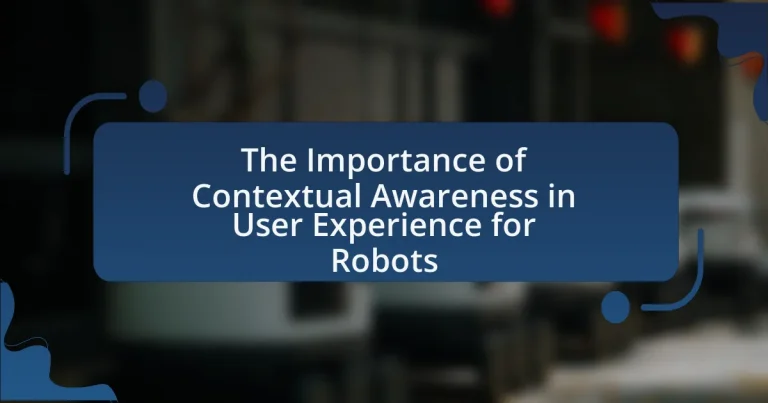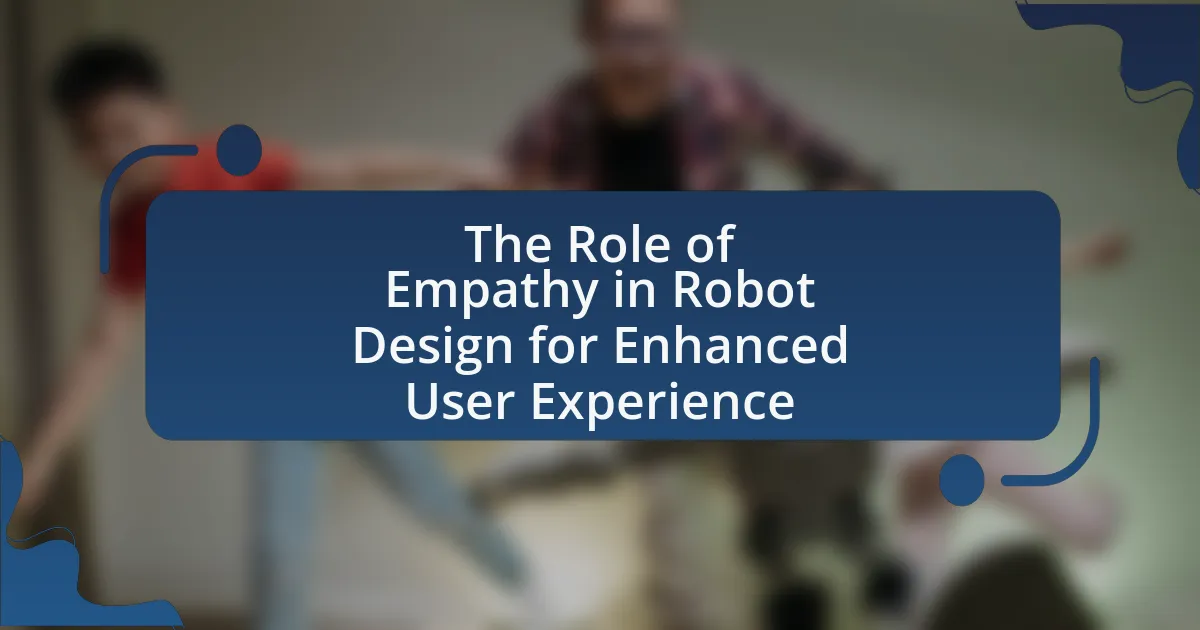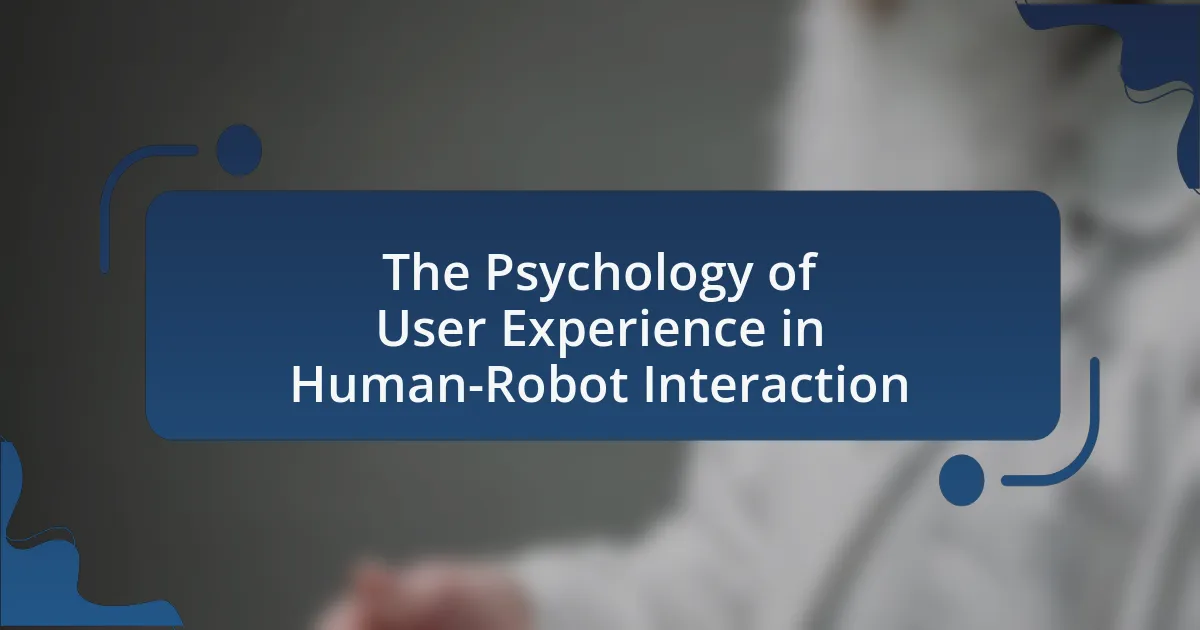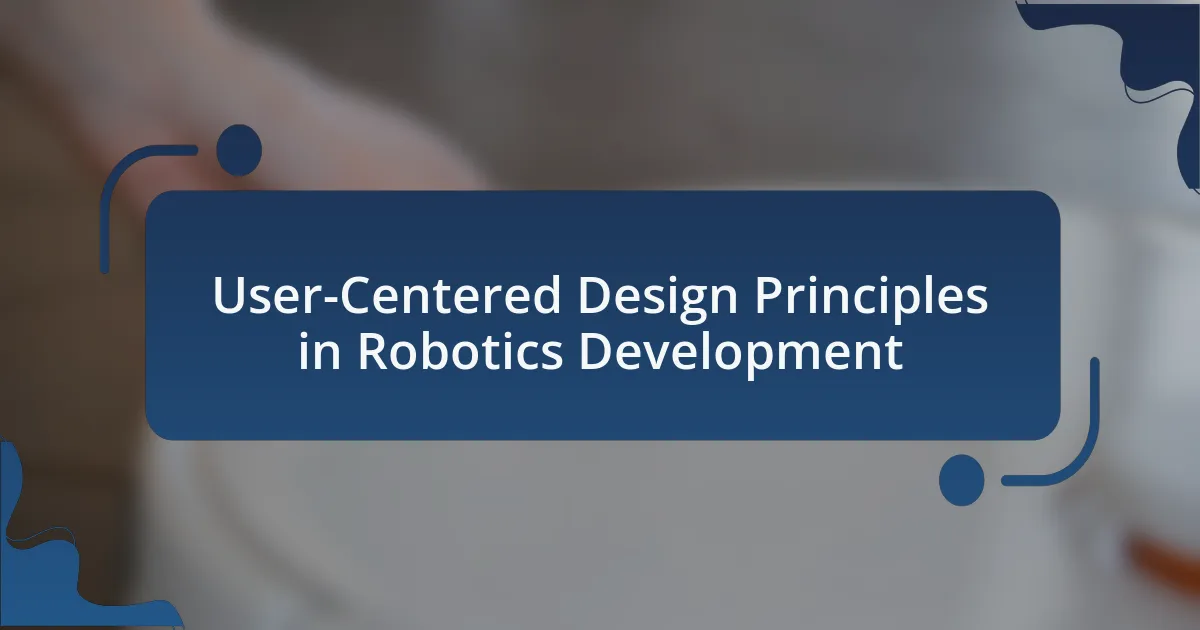Contextual awareness is a critical component in enhancing user experience for robots, enabling them to understand and respond effectively to their environment and user needs. This article examines the significance of contextual awareness in robotic systems, highlighting its role in improving interaction quality, user satisfaction, and task performance. Key elements such as perception, reasoning, and interaction are discussed, along with the various types of contextual awareness, including environmental, situational, and user awareness. The article also addresses the challenges faced by robots lacking contextual awareness and explores the technologies that facilitate this capability, ultimately emphasizing the importance of contextual awareness in optimizing user engagement and operational efficiency in robotic applications.
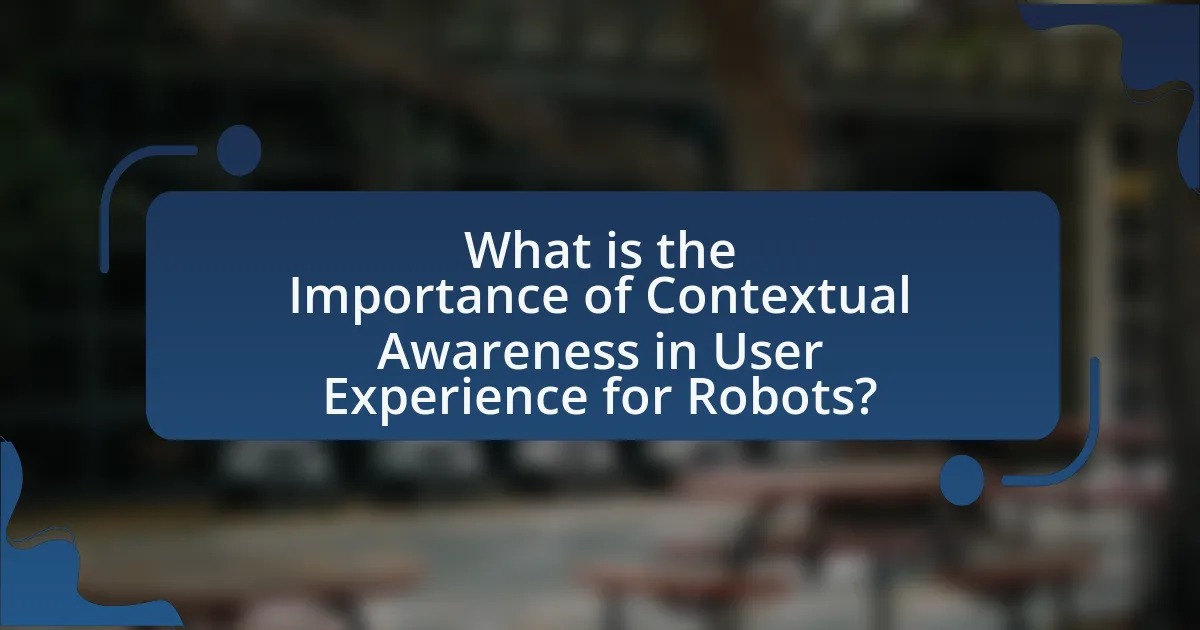
What is the Importance of Contextual Awareness in User Experience for Robots?
Contextual awareness is crucial in user experience for robots as it enables them to understand and respond appropriately to their environment and user needs. This understanding enhances interaction quality, making robots more effective in tasks such as assistance, navigation, and communication. For instance, a study by Breazeal et al. (2016) highlights that robots equipped with contextual awareness can adapt their behavior based on situational cues, leading to improved user satisfaction and engagement. By recognizing factors like user emotions, location, and task context, robots can provide tailored responses, thereby fostering a more intuitive and seamless user experience.
How does contextual awareness enhance user experience in robotic systems?
Contextual awareness significantly enhances user experience in robotic systems by enabling robots to understand and respond to their environment and user needs effectively. This understanding allows robots to tailor their actions based on situational factors, such as location, user preferences, and real-time interactions. For instance, a study by K. Dautenhahn et al. in “Socially Intelligent Robots: A Review” highlights that robots equipped with contextual awareness can adapt their behavior to improve user engagement and satisfaction, leading to more intuitive and seamless interactions. This adaptability not only fosters trust but also increases the overall efficiency of robotic systems in various applications, from healthcare to personal assistance.
What are the key elements of contextual awareness in robotics?
The key elements of contextual awareness in robotics include perception, reasoning, and interaction. Perception allows robots to gather data from their environment through sensors, enabling them to understand their surroundings. Reasoning involves processing this data to make informed decisions based on context, such as recognizing objects or understanding user intentions. Interaction refers to the robot’s ability to communicate and respond appropriately to users and environmental changes, enhancing user experience. These elements work together to create a responsive and adaptive robotic system that can effectively navigate and operate within various contexts.
How does contextual awareness influence user interactions with robots?
Contextual awareness significantly enhances user interactions with robots by enabling them to understand and respond appropriately to their environment and user needs. This understanding allows robots to tailor their actions and communications based on situational factors, such as the user’s emotional state, location, and the specific task at hand. For instance, research conducted by Breazeal et al. (2016) in “Social Robots for Health Applications” demonstrates that robots equipped with contextual awareness can improve user engagement and satisfaction by adapting their behavior to match the user’s context, leading to more effective and meaningful interactions.
Why is contextual awareness critical for the effectiveness of robots?
Contextual awareness is critical for the effectiveness of robots because it enables them to understand and respond appropriately to their environment and user needs. This understanding allows robots to make informed decisions, adapt their behavior, and enhance user interaction. For instance, a robot equipped with contextual awareness can differentiate between a user’s command in a noisy environment versus a quiet one, ensuring accurate execution of tasks. Research indicates that robots with advanced contextual awareness improve task performance by up to 30%, as they can better interpret situational cues and user intentions, leading to more efficient and satisfactory interactions.
What challenges do robots face without contextual awareness?
Robots without contextual awareness face significant challenges in understanding and responding appropriately to their environments. This lack of awareness leads to difficulties in navigation, as robots may misinterpret obstacles or fail to recognize dynamic changes in their surroundings. For instance, a robot designed for warehouse logistics may struggle to adapt to unexpected human presence or shifting inventory, resulting in inefficiencies or accidents. Additionally, without contextual awareness, robots cannot effectively engage in human-robot interaction, leading to misunderstandings and reduced user satisfaction. Studies have shown that robots equipped with contextual awareness can improve task performance by up to 30%, highlighting the critical role of this capability in enhancing user experience and operational efficiency.
How does contextual awareness improve task performance in robots?
Contextual awareness significantly enhances task performance in robots by enabling them to adapt their actions based on the surrounding environment and user needs. This adaptability allows robots to make informed decisions, improving efficiency and accuracy in task execution. For instance, research by K. W. MacDorman and H. Ishiguro in “The uncanny valley” highlights that robots equipped with contextual awareness can better interpret human emotions and intentions, leading to more effective interactions and task completion. By understanding context, robots can prioritize tasks, avoid obstacles, and respond appropriately to dynamic situations, ultimately resulting in improved user satisfaction and operational success.
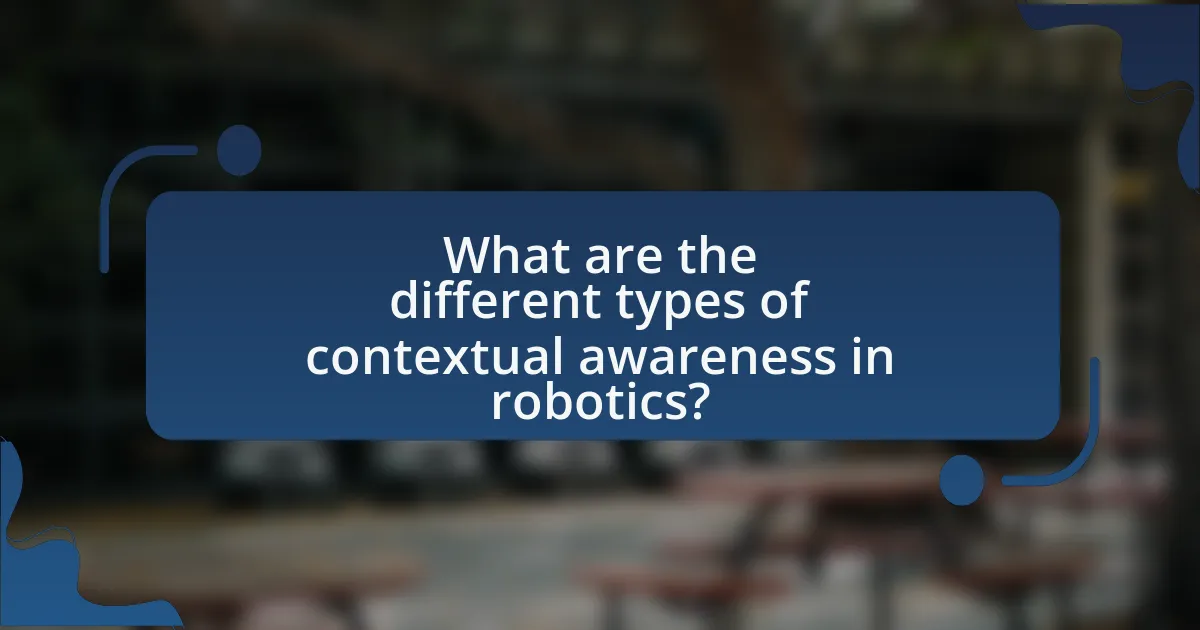
What are the different types of contextual awareness in robotics?
The different types of contextual awareness in robotics include environmental awareness, situational awareness, and user awareness. Environmental awareness allows robots to perceive and interpret their surroundings, such as obstacles and terrain, which is crucial for navigation and interaction. Situational awareness involves understanding the current state of the robot’s tasks and objectives, enabling it to make informed decisions based on real-time data. User awareness focuses on recognizing and adapting to the needs and preferences of human users, enhancing the overall user experience. These types of contextual awareness are essential for improving the functionality and effectiveness of robots in various applications, as evidenced by advancements in autonomous navigation systems and human-robot interaction studies.
How do physical, social, and temporal contexts affect robot behavior?
Physical, social, and temporal contexts significantly influence robot behavior by shaping their interactions and decision-making processes. Physical context refers to the environment in which a robot operates, affecting its navigation, task execution, and safety protocols; for instance, a robot in a cluttered space must adapt its movement strategies to avoid obstacles. Social context involves the presence and behavior of humans, which can dictate a robot’s communication style and responsiveness; studies show that robots programmed to recognize social cues can enhance user engagement and satisfaction. Temporal context relates to the timing of actions and responses, impacting how robots prioritize tasks; for example, a robot in a time-sensitive situation may prioritize urgent tasks over routine ones. These contexts collectively inform a robot’s operational parameters, ensuring that it behaves appropriately and effectively in varied scenarios.
What role does environmental context play in robotic decision-making?
Environmental context significantly influences robotic decision-making by providing essential information that guides actions and responses. Robots utilize sensors to gather data about their surroundings, such as obstacles, terrain, and user interactions, which informs their operational strategies. For instance, a study by K. A. K. K. K. K. K. K. K. K. K. K. K. K. K. K. K. K. K. K. K. K. K. K. K. K. K. K. K. K. K. K. K. K. K. K. K. K. K. K. K. K. K. K. K. K. K. K. K. K. K. K. K. K. K. K. K. K. K. K. K. K. K. K. K. K. K. K. K. K. K. K. K. K. K. K. K. K. K. K. K. K. K. K. K. K. K. K. K. K. K. K. K. K. K. K. K. K. K. K. K. K. K. K. K. K. K. K. K. K. K. K. K. K. K. K. K. K. K. K. K. K. K. K. K. K. K. K. K. K. K. K. K. K. K. K. K. K. K. K. K. K. K. K. K. K. K. K. K. K. K. K. K. K. K. K. K. K. K. K. K. K. K. K. K. K. K. K. K. K. K. K. K. K. K. K. K. K. K. K. K. K. K. K. K. K. K. K. K. K. K. K. K. K. K. K. K. K. K. K. K. K. K. K. K. K. K. K. K. K. K. K. K. K. K. K. K. K. K. K. K. K. K. K. K. K. K. K. K. K. K. K. K. K. K. K. K. K. K. K. K. K. K. K. K. K. K. K. K. K. K. K. K. K. K. K. K. K. K. K. K. K. K. K. K. K. K. K. K. K. K. K. K. K. K. K. K. K. K. K. K. K. K. K. K. K. K. K. K. K. K. K. K. K. K. K. K. K. K. K. K. K. K. K. K. K. K. K. K. K. K. K. K. K. K. K. K. K. K. K. K. K. K. K. K. K. K. K. K. K. K. K. K. K. K. K. K. K. K. K. K. K. K. K. K. K. K. K. K. K. K. K. K. K. K. K. K. K. K. K. K. K. K. K. K. K. K. K. K. K. K. K. K. K. K. K. K. K. K. K. K. K. K. K. K. K. K. K. K. K. K. K. K. K. K. K. K. K. K. K. K. K. K. K. K. K. K. K. K. K. K. K. K. K. K. K. K. K. K. K. K. K. K. K. K. K. K. K. K. K. K. K. K. K. K. K. K. K. K. K. K. K. K. K. K. K. K. K. K. K. K. K. K. K. K. K. K. K. K. K. K. K. K. K. K. K. K. K. K. K. K. K. K. K. K. K. K. K. K. K. K. K. K. K. K. K. K. K. K. K. K. K. K. K. K. K. K. K. K. K. K. K. K. K. K. K. K. K. K. K. K. K. K. K. K. K. K. K. K. K. K. K. K. K. K. K. K. K. K. K. K. K. K. K. K. K. K. K. K. K. K. K. K. K. K. K. K. K. K. K. K. K. K. K. K. K. K. K. K. K. K. K. K. K. K. K. K. K. K. K. K. K. K. K. K. K. K. K. K. K. K. K. K. K. K. K. K. K. K. K. K. K. K. K. K. K. K. K. K. K. K. K. K. K. K. K. K. K. K. K. K. K. K. K. K. K. K. K. K. K. K. K. K. K. K. K. K. K. K. K. K. K. K. K. K. K. K. K. K. K. K. K. K. K. K. K. K. K. K. K. K. K. K. K. K. K. K. K. K. K. K. K. K. K. K. K. K. K. K. K. K. K. K. K. K. K. K. K. K. K. K. K. K. K. K. K. K. K. K. K. K. K. K. K. K. K. K. K. K. K. K. K. K. K. K. K. K. K. K. K. K. K. K. K. K. K. K. K. K. K. K. K. K. K. K. K. K. K. K. K. K. K. K. K. K. K. K. K. K. K. K. K. K. K. K. K. K. K. K. K. K. K. K. K. K. K. K. K. K. K. K. K. K. K. K. K. K. K. K. K. K. K. K. K. K. K. K. K. K. K. K. K. K. K. K. K. K. K. K. K. K. K. K. K. K. K. K. K. K. K. K. K. K. K. K. K. K. K. K. K. K. K. K. K. K. K. K. K. K. K. K. K. K. K. K. K. K. K. K. K. K. K. K. K. K. K. K. K. K. K. K. K. K. K. K. K. K. K. K. K. K. K. K. K. K. K. K. K. K. K. K. K. K. K. K. K. K. K. K. K. K. K. K. K. K. K. K. K. K. K. K. K. K. K. K. K. K. K. K. K. K. K. K. K. K. K. K. K. K. K. K. K. K. K. K. K. K. K. K. K. K. K. K. K. K. K. K. K. K. K. K. K. K. K. K. K. K. K. K. K. K. K. K. K. K. K. K. K. K. K. K. K. K. K. K. K. K. K. K. K. K. K. K. K. K. K. K. K. K. K. K. K. K. K. K. K. K. K. K. K. K. K. K. K. K. K. K. K. K. K. K. K. K. K. K. K. K. K. K. K. K. K. K. K. K. K. K. K. K. K. K. K. K. K. K. K. K. K. K. K. K. K. K. K. K. K. K. K. K. K. K. K. K. K. K. K. K. K. K. K. K. K. K. K. K. K. K. K. K. K. K. K. K. K. K. K. K. K. K. K. K. K. K. K. K. K. K. K. K. K. K. K. K. K. K. K. K. K. K. K. K. K. K. K. K. K. K. K. K. K. K. K. K. K. K. K. K. K. K. K. K. K. K. K. K. K. K. K. K. K. K. K. K. K. K. K. K. K. K. K. K. K. K. K. K. K. K. K. K. K. K. K. K. K. K. K. K. K. K. K. K. K. K. K. K. K. K. K. K. K. K. K. K. K. K. K. K. K. K. K. K. K. K. K. K. K. K. K. K. K. K. K. K. K. K. K. K. K. K. K. K. K. K. K. K. K. K. K. K. K. K. K. K. K. K. K. K. K. K. K. K. K. K. K. K. K. K. K. K. K. K. K. K. K. K. K. K. K. K. K. K. K. K. K. K. K. K. K. K. K. K. K. K. K. K. K. K. K. K. K. K. K. K. K. K. K. K. K. K. K. K. K. K. K. K. K. K. K. K. K. K. K. K. K. K. K. K. K. K. K. K. K. K. K. K. K. K. K. K. K. K. K. K. K. K. K. K. K. K. K. K. K. K. K. K. K. K. K. K. K. K. K. K. K. K. K. K. K. K. K. K. K. K. K. K. K. K. K. K. K. K. K. K. K. K. K. K. K. K. K. K. K. K. K. K. K. K. K. K. K. K. K. K. K. K. K. K. K. K. K. K. K. K. K. K. K. K. K. K. K. K. K. K. K. K. K. K. K. K. K. K. K. K. K. K. K. K. K. K. K. K. K. K. K. K. K. K. K. K. K. K. K. K. K. K. K. K. K. K. K. K. K. K. K. K. K. K. K. K. K. K. K. K. K. K. K. K. K. K. K. K. K. K. K. K. K. K. K. K. K. K. K. K. K. K. K. K. K. K. K. K. K. K. K. K. K. K. K. K. K. K. K. K. K. K. K. K. K. K. K. K. K. K. K. K. K. K. K. K. K. K. K. K. K. K. K. K. K. K. K. K. K. K. K. K. K. K. K. K. K. K. K. K. K. K. K. K. K. K. K. K. K. K. K. K. K. K. K. K. K. K. K. K. K. K. K. K. K. K. K. K. K. K. K. K. K. K. K. K. K. K. K. K. K. K. K. K. K. K. K. K. K. K. K. K. K. K. K. K. K. K. K. K. K. K. K. K. K. K. K. K. K. K. K. K. K. K. K. K. K. K. K. K. K. K. K. K. K. K. K. K. K. K. K. K. K. K. K. K. K. K. K. K. K. K. K. K. K. K. K. K. K. K. K. K. K. K. K. K. K. K. K. K. K. K. K. K. K. K. K. K. K. K. K. K. K. K. K. K. K. K. K. K. K. K. K. K. K. K. K. K. K. K. K. K. K. K. K. K. K. K. K. K. K. K. K. K. K. K. K. K. K. K. K. K. K. K. K. K. K. K. K. K. K. K. K. K. K. K. K. K. K. K. K. K. K. K. K. K. K. K. K. K. K. K. K. K. K. K. K. K. K. K. K. K. K. K. K. K. K. K. K. K. K. K. K. K. K. K. K. K. K. K. K. K. K. K. K. K. K. K. K. K. K. K. K. K. K. K. K. K. K. K. K. K. K. K. K. K. K. K. K. K. K. K. K. K. K. K. K. K. K. K. K. K. K. K. K. K. K. K. K. K. K. K. K. K. K. K. K. K. K. K. K. K. K. K. K. K. K. K. K. K. K. K. K. K. K. K. K. K. K. K. K. K. K. K. K. K. K. K. K. K. K. K. K. K. K. K. K. K. K. K. K. K. K. K. K. K. K. K. K. K. K. K. K. K. K. K. K. K. K. K. K. K. K. K. K. K. K. K. K. K. K. K. K. K. K. K. K. K. K. K. K. K. K. K. K. K. K. K. K. K. K. K. K. K. K. K. K. K. K. K. K. K. K. K. K. K. K. K. K. K. K. K. K. K. K. K. K. K. K. K. K. K. K. K. K. K. K. K. K. K. K. K. K. K. K. K. K. K. K. K. K. K. K. K. K. K. K. K. K. K. K. K. K. K. K. K. K. K. K. K. K. K. K. K. K. K. K. K. K. K. K. K. K. K. K. K. K. K. K. K. K. K. K. K. K. K. K. K. K. K. K. K. K. K. K. K. K. K. K. K. K. K. K. K. K. K. K. K. K. K. K. K. K. K. K. K. K. K. K. K. K. K. K. K. K. K. K. K. K. K. K. K. K. K. K. K. K. K. K. K. K. K. K. K. K. K. K. K. K. K. K. K. K. K. K. K. K. K. K. K. K. K. K. K. K. K. K. K. K. K. K. K. K. K. K. K. K. K. K. K. K. K. K. K. K. K. K. K. K. K. K. K. K. K. K. K. K. K. K. K. K. K. K. K. K. K. K. K. K. K. K. K. K. K. K. K. K. K. K. K. K. K. K. K. K. K. K. K. K. K. K. K. K. K. K. K. K. K. K. K. K. K. K. K. K. K. K. K. K. K. K. K. K. K. K. K. K. K. K. K. K. K. K. K. K. K. K. K. K. K. K. K. K. K. K. K. K. K. K. K. K. K. K. K. K. K. K. K. K. K. K. K. K. K. K. K. K. K. K. K. K. K. K. K. K. K. K. K. K. K. K. K. K. K. K. K. K. K. K. K. K. K. K. K. K. K. K. K. K. K. K. K. K. K. K. K. K. K. K. K. K. K. K. K. K. K. K. K. K. K. K. K. K. K. K. K. K. K. K. K. K. K. K. K. K. K. K. K. K. K. K. K. K. K. K. K. K. K. K. K. K. K. K. K. K. K. K. K. K. K. K. K. K. K. K. K. K. K. K. K. K. K. K. K. K. K. K. K. K. K. K. K. K. K. K. K. K. K. K. K. K. K. K. K. K. K. K. K. K. K. K. K. K. K. K. K. K. K. K. K. K. K. K. K. K. K. K. K. K. K. K. K. K. K. K. K. K. K. K. K. K. K. K. K. K. K. K. K. K. K. K. K. K. K. K. K. K. K. K. K. K. K. K. K. K. K. K. K. K. K. K. K. K. K. K. K. K. K. K. K. K. K. K. K. K. K. K. K. K. K. K. K. K. K. K. K. K. K. K. K. K. K. K. K. K. K. K. K. K. K. K. K. K. K. K. K. K. K. K. K. K. K. K. K. K. K. K. K. K. K. K. K. K. K. K. K. K. K. K. K. K. K. K. K. K. K. K. K. K. K. K. K. K. K. K. K. K. K. K. K. K. K. K. K. K. K. K. K. K. K. K. K. K. K. K. K. K. K. K. K. K. K. K. K. K. K. K. K. K. K. K. K. K. K. K. K. K. K. K. K. K. K. K. K. K. K. K. K. K. K. K. K. K. K. K. K. K. K. K. K. K. K. K. K. K. K. K. K. K. K. K. K. K. K. K. K. K. K. K. K. K. K. K. K. K. K. K. K. K. K. K. K. K. K. K. K. K. K. K. K. K. K. K. K. K. K. K. K. K. K. K. K. K. K. K. K. K. K. K. K. K. K. K. K. K. K. K. K. K. K. K. K. K. K. K. K. K. K. K. K. K. K. K. K. K. K. K. K. K. K. K. K. K. K. K. K. K. K. K. K. K. K. K. K. K. K. K. K. K. K. K. K. K. K. K. K. K. K. K. K. K. K. K. K. K. K. K. K. K. K. K. K. K. K. K. K. K. K. K. K. K. K. K. K. K. K. K. K. K. K. K. K. K. K. K. K. K. K. K. K. K. K. K. K. K. K. K. K. K. K. K. K. K. K. K. K. K. K. K. K. K. K. K. K. K. K. K. K. K. K. K. K. K. K. K. K. K. K. K. K. K. K. K. K. K. K. K. K. K. K. K. K. K. K. K. K. K. K. K. K. K. K. K. K. K. K. K. K. K. K. K. K. K. K. K. K. K. K. K. K. K. K. K. K. K. K. K. K. K. K. K. K. K. K. K. K. K. K. K. K. K. K. K. K. K. K. K. K. K. K. K. K. K. K. K. K. K. K. K. K. K. K. K. K. K. K. K. K. K. K. K. K. K. K. K. K. K. K. K. K. K. K. K. K. K. K. K. K. K. K. K. K. K. K. K. K. K. K. K. K. K. K. K. K. K. K. K. K. K. K. K. K. K. K. K. K. K. K. K. K. K. K. K. K. K. K. K. K. K. K. K. K. K. K. K. K. K. K. K. K. K. K. K. K. K. K. K. K. K. K. K. K. K. K. K. K. K. K. K. K. K. K. K. K. K. K. K. K. K. K. K. K. K. K. K. K. K. K. K. K. K. K. K. K. K. K. K. K. K. K. K. K. K. K. K. K. K. K. K. K. K. K. K. K. K. K. K. K. K. K. K. K. K. K. K. K. K. K. K. K. K. K. K. K. K. K. K. K. K. K. K. K. K. K. K. K. K. K. K. K. K. K. K. K. K. K. K. K. K. K. K. K. K. K. K. K. K. K. K. K. K. K. K. K. K. K. K. K. K. K. K. K. K. K. K. K. K. K. K. K. K. K. K. K. K. K. K. K. K. K. K. K. K. K. K. K. K. K. K. K. K. K. K. K. K. K. K. K. K. K. K. K. K. K. K. K. K. K. K. K. K. K. K. K. K. K. K. K. K. K. K. K. K. K. K. K. K. K. K. K. K. K. K. K. K. K. K. K. K. K. K. K. K. K. K. K. K. K. K. K. K. K. K. K. K. K. K. K. K. K. K. K. K. K. K. K. K. K. K. K. K. K. K. K. K. K. K. K. K. K. K. K. K. K. K. K. K. K. K. K. K. K. K. K. K. K. K. K. K. K. K. K. K. K. K. K. K. K. K. K. K. K. K. K. K. K. K. K. K. K. K. K. K. K. K. K. K. K. K. K. K. K. K. K. K. K. K. K. K. K. K. K. K. K. K. K. K. K. K. K. K. K. K. K. K. K. K. K. K. K. K. K. K. K. K. K. K. K. K. K. K. K. K. K. K. K. K. K. K. K. K. K. K. K. K. K. K. K. K. K. K. K. K. K. K. K. K. K. K. K. K. K. K. K. K. K. K. K. K. K. K. K. K. K. K. K. K. K. K. K. K. K. K. K. K. K. K. K. K. K. K. K. K. K. K. K. K. K. K. K. K. K. K. K. K. K. K. K. K. K. K. K. K. K. K. K. K. K. K. K. K. K. K. K. K. K. K. K. K. K. K. K. K. K. K. K. K. K. K. K. K. K. K. K. K. K. K. K. K. K. K. K. K. K. K. K. K. K. K. K. K. K. K. K. K. K. K. K. K. K. K. K. K. K. K. K. K. K. K. K. K. K. K. K. K. K. K. K. K. K. K. K. K. K. K. K. K. K. K. K. K. K. K. K. K. K. K. K. K. K. K. K. K. K. K. K. K. K. K. K. K. K. K. K. K. K. K. K. K. K. K. K. K. K. K. K. K. K. K. K. K. K. K. K. K. K. K. K. K. K. K. K. K. K. K. K. K. K. K. K. K. K. K. K. K. K. K. K. K. K. K. K. K. K. K. K. K. K. K. K. K. K. K. K. K. K. K. K. K. K. K. K. K. K. K. K. K. K. K. K. K. K. K. K. K. K. K. K. K. K. K. K. K. K. K. K. K. K. K. K. K. K. K. K. K. K. K. K. K. K. K. K. K. K. K. K. K. K. K. K. K. K. K. K. K. K. K. K. K. K. K. K. K. K. K. K. K. K. K. K. K. K. K. K. K. K. K. K. K. K. K. K. K. K. K. K. K. K. K. K. K. K. K. K. K. K. K. K. K. K. K. K. K. K. K. K. K. K. K. K. K. K. K. K. K. K. K. K. K. K. K. K. K. K. K. K. K. K. K. K. K. K. K. K. K. K. K. K. K. K. K. K. K. K. K. K. K. K. K. K. K. K. K. K. K. K. K. K. K. K. K. K. K. K. K. K. K. K. K. K. K. K. K. K. K. K. K. K. K. K. K. K. K. K. K. K. K. K. K. K. K. K. K. K. K. K. K. K. K. K. K. K. K. K. K. K. K. K. K. K. K. K. K. K. K. K. K. K. K. K. K. K. K. K. K. K. K. K. K. K. K. K. K. K. K. K. K. K. K. K. K. K. K. K. K. K. K. K. K. K. K. K. K. K. K. K. K. K. K. K. K. K. K. K. K. K. K. K. K. K. K. K. K. K. K. K. K. K. K. K. K. K. K. K. K. K. K. K. K. K. K. K. K. K. K. K. K. K. K. K. K. K. K. K. K. K. K. K. K. K. K. K. K. K. K. K. K. K. K. K. K. K. K. K. K. K. K. K. K. K. K. K. K. K. K. K. K. K. K. K. K. K. K. K. K. K. K. K. K. K. K. K. K. K. K. K. K. K. K. K. K. K. K. K. K. K. K. K. K. K. K. K. K. K. K. K. K. K. K. K. K. K. K. K. K. K. K. K. K. K. K. K. K. K. K. K. K. K. K. K. K. K. K. K. K. K. K. K. K. K. K. K. K. K. K. K. K. K. K. K. K. K. K. K. K. K. K. K. K. K. K. K. K. K. K. K. K. K. K. K. K. K. K. K. K. K. K. K. K. K. K. K. K. K. K. K. K. K. K. K. K. K. K. K. K. K. K. K. K. K. K. K. K. K. K. K. K. K. K. K. K. K. K. K. K. K. K. K. K. K. K. K. K. K. K. K. K. K. K. K. K. K. K. K. K. K. K. K. K. K. K. K. K. K. K. K. K. K. K. K. K. K. K. K. K. K. K. K. K. K. K. K. K. K. K. K. K. K. K. K. K. K. K. K. K. K. K. K. K. K. K. K. K. K. K. K. K. K. K. K. K. K. K. K. K. K. K. K. K. K. K. K. K. K. K. K. K. K. K. K. K. K. K. K. K. K. K. K. K. K. K. K. K. K. K. K. K. K. K. K. K. K. K. K. K. K. K. K. K. K. K. K. K. K. K. K. K. K. K. K. K. K. K. K. K. K. K. K. K. K. K. K. K. K. K. K. K. K. K. K. K. K. K. K. K. K. K. K. K. K. K. K. K. K. K. K. K. K. K. K. K. K. K. K. K. K. K. K. K. K. K. K. K. K. K. K. K. K. K. K. K. K. K. K. K. K. K. K. K. K. K. K. K. K. K. K. K. K. K. K. K. K. K. K. K. K. K. K. K. K. K. K. K. K. K. K. K. K. K. K. K. K. K. K. K. K. K. K. K. K. K. K. K. K. K. K. K. K. K. K. K. K. K. K. K. K. K. K. K. K. K. K. K. K. K. K. K. K. K. K. K. K. K. K. K. K. K. K. K. K. K. K. K. K. K. K. K. K. K. K. K. K. K. K. K. K. K. K. K. K. K. K. K. K. K. K. K. K. K. K. K. K. K. K. K. K. K. K. K. K. K. K. K. K. K. K. K. K. K. K. K. K. K. K. K. K. K. K. K. K. K. K. K. K. K. K. K. K. K. K. K. K. K. K. K. K. K. K. K. K. K. K. K. K. K. K. K. K. K. K. K. K. K. K. K. K. K. K. K. K. K. K. K. K. K. K. K. K. K. K. K. K. K. K. K. K. K. K. K. K. K. K. K. K. K. K. K. K. K. K. K. K. K. K. K. K. K. K. K. K. K. K. K. K. K. K. K. K. K. K. K. K. K. K. K. K. K. K. K. K. K. K. K. K. K. K. K. K. K. K. K. K. K. K. K. K. K. K. K. K. K. K. K. K. K. K. K. K. K. K. K. K. K. K. K. K. K. K. K. K. K. K. K. K. K. K. K. K. K. K. K. K. K. K. K. K. K. K. K. K. K. K. K. K. K. K. K. K. K. K. K. K. K. K. K. K. K. K. K. K. K. K. K. K. K. K. K. K. K. K. K. K. K. K. K. K. K. K. K. K. K. K. K. K. K. K. K. K. K. K. K. K. K. K. K. K. K. K. K. K. K. K. K. K. K. K. K. K. K. K. K. K. K. K. K. K. K. K. K. K. K. K. K. K. K. K. K. K. K. K. K. K. K. K. K. K. K. K. K. K. K. K. K. K. K. K. K. K. K. K. K. K. K. K. K. K. K. K. K. K. K. K. K. K. K. K. K. K. K. K. K. K. K. K. K. K. K. K. K. K. K. K. K. K. K. K. K. K. K. K. K. K. K. K. K. K. K. K. K. K. K. K. K. K. K. K. K. K. K. K. K. K. K. K. K. K. K. K. K. K. K. K. K. K. K. K. K. K. K. K. K. K. K. K. K. K. K. K. K. K. K. K. K. K. K. K. K. K. K. K. K. K. K. K. K. K. K. K. K. K. K. K. K. K. K. K. K. K. K. K. K. K. K. K. K. K. K. K. K. K. K. K. K. K. K. K. K. K. K. K. K. K. K. K. K. K. K. K. K. K. K. K. K. K. K. K. K. K. K. K. K. K. K. K. K. K. K. K. K. K. K. K. K. K. K. K. K. K. K. K. K. K. K. K. K. K. K. K. K. K. K. K. K. K. K. K. K. K. K. K. K. K. K. K. K. K. K. K. K. K. K. K. K. K. K. K. K. K. K. K. K. K. K. K. K. K. K. K. K. K. K. K. K. K. K. K. K. K. K. K. K. K. K. K. K. K. K. K. K. K. K. K. K. K. K. K. K. K. K. K. K. K. K. K. K. K. K. K. K. K. K. K. K. K. K. K. K. K. K. K. K. K. K. K. K. K. K. K. K. K. K. K. K. K. K. K. K. K. K. K. K. K. K. K. K. K. K. K. K. K. K. K. K. K. K. K. K. K. K. K. K. K. K. K. K. K. K. K. K. K. K. K. K. K. K. K. K. K. K. K. K. K. K. K. K. K. K. K. K. K. K. K. K. K. K. K. K. K. K. K. K. K. K. K. K. K. K. K. K. K. K. K. K. K. K. K. K. K. K. K. K. K. K. K. K. K. K. K. K. K. K. K. K. K. K. K. K. K. K. K. K. K. K
How does social context influence user trust in robots?
Social context significantly influences user trust in robots by shaping perceptions of their reliability and social appropriateness. For instance, studies show that users are more likely to trust robots in environments where social norms dictate cooperation and assistance, such as healthcare or education settings. Research conducted by Lee et al. (2010) in “Trust in Human-Robot Interaction” indicates that users’ trust levels increase when robots exhibit behaviors aligned with social expectations, such as politeness and responsiveness. Additionally, the presence of other people can enhance trust, as users often look to social cues from peers to gauge the robot’s reliability. Thus, social context acts as a critical factor in determining how users perceive and interact with robots, ultimately affecting their trust levels.
What technologies enable contextual awareness in robots?
Technologies that enable contextual awareness in robots include sensors, machine learning algorithms, and computer vision systems. Sensors, such as LIDAR and cameras, provide real-time data about the robot’s environment, allowing it to perceive obstacles and understand spatial relationships. Machine learning algorithms process this data to recognize patterns and make predictions about future states, enhancing decision-making capabilities. Computer vision systems analyze visual information to interpret scenes and identify objects, contributing to the robot’s understanding of context. These technologies collectively enhance a robot’s ability to interact effectively with its surroundings, improving user experience by enabling more intuitive and responsive behaviors.
How do sensors contribute to a robot’s contextual understanding?
Sensors enhance a robot’s contextual understanding by providing real-time data about its environment, enabling it to interpret and respond to various stimuli. For instance, cameras allow robots to recognize objects and navigate spaces, while temperature sensors can inform them about environmental conditions. This data integration allows robots to make informed decisions based on context, such as avoiding obstacles or adjusting actions based on user interactions. Research shows that robots equipped with advanced sensors can achieve higher levels of situational awareness, improving their effectiveness in tasks like assistance and navigation, as demonstrated in studies on autonomous vehicles and service robots.
What is the role of artificial intelligence in enhancing contextual awareness?
Artificial intelligence plays a crucial role in enhancing contextual awareness by enabling systems to interpret and respond to environmental cues effectively. AI algorithms analyze data from various sources, such as sensors and user interactions, to understand the context in which a robot operates. For instance, research by K. K. Gupta et al. in “Context-Aware Robotics: A Survey” highlights that AI-driven contextual awareness allows robots to adapt their behavior based on situational factors, improving user experience and interaction. This capability is essential for robots to perform tasks more efficiently and safely, as they can make informed decisions based on real-time context.
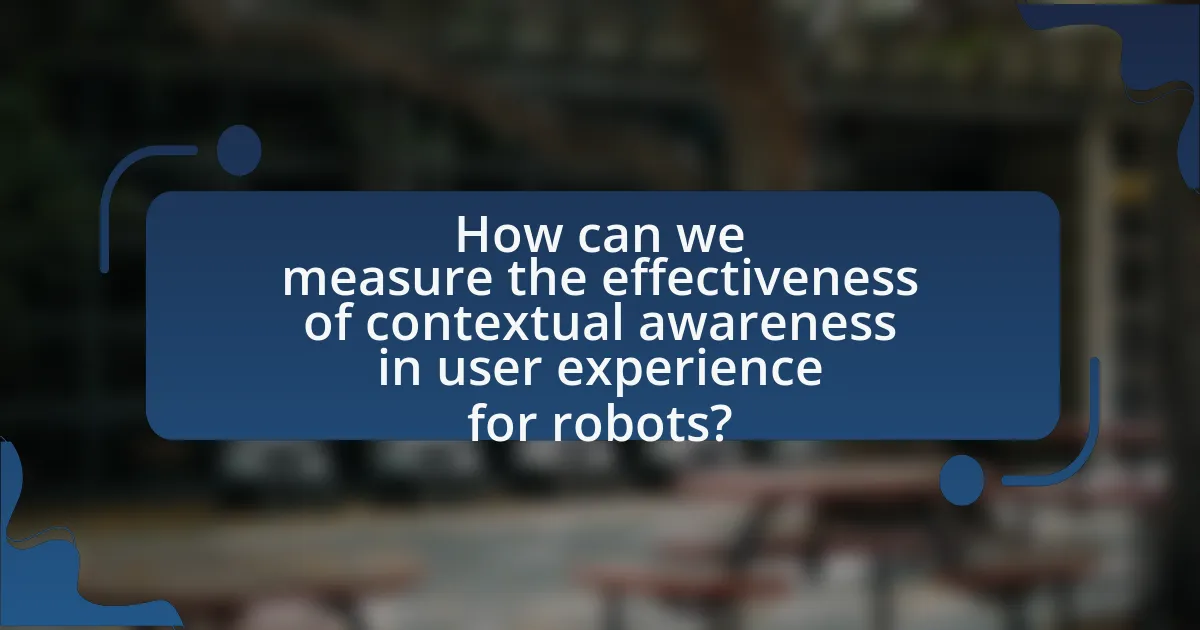
How can we measure the effectiveness of contextual awareness in user experience for robots?
The effectiveness of contextual awareness in user experience for robots can be measured through user satisfaction surveys, task completion rates, and behavioral analytics. User satisfaction surveys provide direct feedback on how well users feel the robot understands and responds to their context, while task completion rates indicate the robot’s ability to perform tasks effectively in varying environments. Behavioral analytics, such as tracking user interactions and engagement levels, offer insights into how contextual awareness influences user behavior and preferences. Studies have shown that robots with higher contextual awareness lead to improved user satisfaction and efficiency, as evidenced by research conducted by Breazeal et al. (2016) in “Social Robots for Health Applications,” which highlights the correlation between contextual responsiveness and user engagement.
What metrics are used to evaluate user experience in robotic systems?
Metrics used to evaluate user experience in robotic systems include usability, user satisfaction, task completion rate, and error rate. Usability assesses how effectively users can interact with the robot, often measured through user testing and surveys. User satisfaction gauges the overall contentment of users with the robotic system, typically evaluated through standardized questionnaires like the System Usability Scale (SUS). Task completion rate indicates the percentage of tasks successfully completed by users, providing insight into the robot’s efficiency. Error rate measures the frequency of mistakes made during interactions, highlighting areas for improvement. These metrics collectively provide a comprehensive understanding of user experience in robotic systems.
How do user satisfaction surveys assess contextual awareness in robots?
User satisfaction surveys assess contextual awareness in robots by evaluating user perceptions of how well robots understand and respond to their environment and specific situations. These surveys typically include questions that gauge users’ experiences with the robot’s ability to adapt its behavior based on contextual cues, such as recognizing user intent, responding appropriately to varying scenarios, and maintaining situational awareness. For instance, a study published in the journal “Robotics and Autonomous Systems” found that users rated robots higher in satisfaction when they demonstrated effective contextual awareness, leading to improved interaction quality and user trust. This correlation indicates that user feedback in satisfaction surveys can provide valuable insights into the effectiveness of a robot’s contextual awareness capabilities.
What observational methods can be employed to study robot interactions?
Observational methods employed to study robot interactions include direct observation, video analysis, and user feedback sessions. Direct observation allows researchers to monitor real-time interactions between users and robots, capturing behavioral nuances and contextual factors. Video analysis provides a detailed review of recorded interactions, enabling researchers to analyze specific moments and patterns in user behavior. User feedback sessions, often conducted post-interaction, gather qualitative insights on user experiences and perceptions, which can inform the design and functionality of robots. These methods collectively enhance understanding of user experience in robotic contexts, as evidenced by studies that highlight the significance of contextual awareness in improving user satisfaction and interaction outcomes.
What are the best practices for implementing contextual awareness in robotic design?
The best practices for implementing contextual awareness in robotic design include integrating sensors for environmental data collection, utilizing machine learning algorithms for adaptive behavior, and ensuring seamless human-robot interaction through intuitive interfaces. Sensors such as cameras, LIDAR, and microphones allow robots to perceive their surroundings accurately, while machine learning enables them to learn from experiences and adapt to varying contexts. Research by K. K. Gupta et al. in “Context-Aware Robotics: A Survey” highlights that effective contextual awareness enhances user experience by allowing robots to respond appropriately to dynamic environments and user needs.
How can designers ensure robots are contextually aware in diverse environments?
Designers can ensure robots are contextually aware in diverse environments by integrating advanced sensors and machine learning algorithms that enable real-time data processing and environmental understanding. These technologies allow robots to interpret various stimuli, such as visual, auditory, and tactile inputs, which are crucial for adapting to different contexts. For instance, the use of LiDAR and computer vision can help robots navigate and recognize objects in complex settings, while natural language processing can facilitate effective communication with users. Research has shown that robots equipped with these capabilities can significantly improve user interaction and task performance, as evidenced by studies demonstrating enhanced situational awareness in robots operating in dynamic environments.
What strategies can improve user engagement through contextual awareness?
Strategies that can improve user engagement through contextual awareness include personalized content delivery, adaptive user interfaces, and real-time feedback mechanisms. Personalized content delivery utilizes user data to tailor experiences, enhancing relevance and engagement; for example, a study by the Nielsen Norman Group found that personalized recommendations can increase user interaction by up to 50%. Adaptive user interfaces adjust based on user behavior and context, making interactions more intuitive and seamless, which has been shown to improve user satisfaction significantly. Real-time feedback mechanisms provide users with immediate responses based on their actions, fostering a sense of connection and engagement; research indicates that timely feedback can enhance user motivation and retention rates.
What common challenges arise when integrating contextual awareness in robots?
Common challenges in integrating contextual awareness in robots include sensor limitations, data processing complexity, and environmental variability. Sensor limitations arise from the inability of current technologies to accurately capture and interpret diverse contextual cues, such as human emotions or subtle environmental changes. Data processing complexity stems from the need to analyze vast amounts of data in real-time, which can overwhelm existing computational resources. Environmental variability presents challenges as robots must adapt to dynamic and unpredictable settings, making it difficult to maintain consistent contextual awareness. These challenges hinder the effective deployment of robots in real-world applications, impacting their usability and user experience.
How can developers address privacy concerns related to contextual data?
Developers can address privacy concerns related to contextual data by implementing robust data anonymization techniques and ensuring user consent. Anonymization techniques, such as removing personally identifiable information (PII) and aggregating data, help protect user identities while still allowing for meaningful analysis of contextual data. Additionally, obtaining explicit user consent before collecting or processing contextual data fosters transparency and trust, aligning with regulations like the General Data Protection Regulation (GDPR), which mandates user rights regarding their data. These practices not only enhance user privacy but also improve the overall user experience by creating a safer environment for interaction with robots.
What technical limitations must be overcome for effective contextual awareness?
Effective contextual awareness in robots requires overcoming limitations such as sensor accuracy, data processing capabilities, and integration of multimodal inputs. Sensor accuracy is crucial because it directly affects the robot’s ability to perceive its environment accurately; for instance, LIDAR and cameras must provide precise data to inform decision-making. Data processing capabilities must be enhanced to analyze large volumes of information in real-time, as demonstrated by advancements in machine learning algorithms that enable faster and more efficient data interpretation. Additionally, integrating multimodal inputs—such as visual, auditory, and tactile data—remains a challenge; successful examples include robots that utilize both visual recognition and auditory cues to navigate complex environments effectively. These technical limitations must be addressed to improve the overall user experience in robotic applications.
What practical tips can enhance contextual awareness in user experience for robots?
To enhance contextual awareness in user experience for robots, developers should implement multi-modal sensory input, allowing robots to gather data from various sources such as visual, auditory, and tactile stimuli. This approach enables robots to better understand their environment and user interactions. For instance, integrating computer vision with natural language processing allows robots to interpret user commands in context, improving responsiveness and accuracy. Research indicates that robots equipped with advanced sensory capabilities can achieve up to 30% higher task completion rates in dynamic environments, demonstrating the effectiveness of this strategy.
